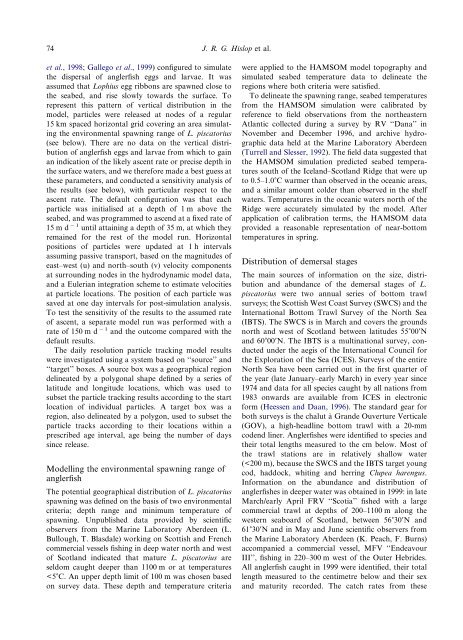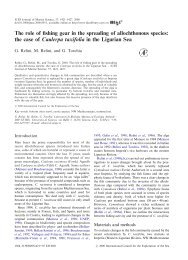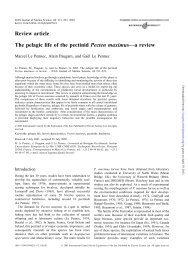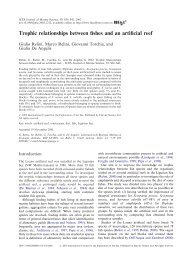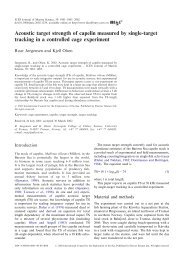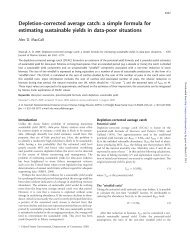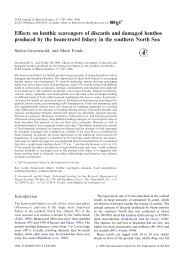A synthesis of the early life history of the anglerfish, Lophius ...
A synthesis of the early life history of the anglerfish, Lophius ...
A synthesis of the early life history of the anglerfish, Lophius ...
You also want an ePaper? Increase the reach of your titles
YUMPU automatically turns print PDFs into web optimized ePapers that Google loves.
74 J. R. G. Hislop et al.<br />
et al., 1998; Gallego et al., 1999) configured to simulate<br />
<strong>the</strong> dispersal <strong>of</strong> <strong>anglerfish</strong> eggs and larvae. It was<br />
assumed that <strong>Lophius</strong> egg ribbons are spawned close to<br />
<strong>the</strong> seabed, and rise slowly towards <strong>the</strong> surface. To<br />
represent this pattern <strong>of</strong> vertical distribution in <strong>the</strong><br />
model, particles were released at nodes <strong>of</strong> a regular<br />
15 km spaced horizontal grid covering an area simulating<br />
<strong>the</strong> environmental spawning range <strong>of</strong> L. piscatorius<br />
(see below). There are no data on <strong>the</strong> vertical distribution<br />
<strong>of</strong> <strong>anglerfish</strong> eggs and larvae from which to gain<br />
an indication <strong>of</strong> <strong>the</strong> likely ascent rate or precise depth in<br />
<strong>the</strong> surface waters, and we <strong>the</strong>refore made a best guess at<br />
<strong>the</strong>se parameters, and conducted a sensitivity analysis <strong>of</strong><br />
<strong>the</strong> results (see below), with particular respect to <strong>the</strong><br />
ascent rate. The default configuration was that each<br />
particle was initialised at a depth <strong>of</strong> 1 m above <strong>the</strong><br />
seabed, and was programmed to ascend at a fixed rate <strong>of</strong><br />
15 m d 1 until attaining a depth <strong>of</strong> 35 m, at which <strong>the</strong>y<br />
remained for <strong>the</strong> rest <strong>of</strong> <strong>the</strong> model run. Horizontal<br />
positions <strong>of</strong> particles were updated at 1 h intervals<br />
assuming passive transport, based on <strong>the</strong> magnitudes <strong>of</strong><br />
east–west (u) and north–south (v) velocity components<br />
at surrounding nodes in <strong>the</strong> hydrodynamic model data,<br />
and a Eulerian integration scheme to estimate velocities<br />
at particle locations. The position <strong>of</strong> each particle was<br />
saved at one day intervals for post-simulation analysis.<br />
To test <strong>the</strong> sensitivity <strong>of</strong> <strong>the</strong> results to <strong>the</strong> assumed rate<br />
<strong>of</strong> ascent, a separate model run was performed with a<br />
rate <strong>of</strong> 150 m d 1 and <strong>the</strong> outcome compared with <strong>the</strong><br />
default results.<br />
The daily resolution particle tracking model results<br />
were investigated using a system based on ‘‘source’’ and<br />
‘‘target’’ boxes. A source box was a geographical region<br />
delineated by a polygonal shape defined by a series <strong>of</strong><br />
latitude and longitude locations, which was used to<br />
subset <strong>the</strong> particle tracking results according to <strong>the</strong> start<br />
location <strong>of</strong> individual particles. A target box was a<br />
region, also delineated by a polygon, used to subset <strong>the</strong><br />
particle tracks according to <strong>the</strong>ir locations within a<br />
prescribed age interval, age being <strong>the</strong> number <strong>of</strong> days<br />
since release.<br />
Modelling <strong>the</strong> environmental spawning range <strong>of</strong><br />
<strong>anglerfish</strong><br />
The potential geographical distribution <strong>of</strong> L. piscatorius<br />
spawning was defined on <strong>the</strong> basis <strong>of</strong> two environmental<br />
criteria; depth range and minimum temperature <strong>of</strong><br />
spawning. Unpublished data provided by scientific<br />
observers from <strong>the</strong> Marine Laboratory Aberdeen (L.<br />
Bullough, T. Blasdale) working on Scottish and French<br />
commercial vessels fishing in deep water north and west<br />
<strong>of</strong> Scotland indicated that mature L. piscatorius are<br />
seldom caught deeper than 1100 m or at temperatures<br />


